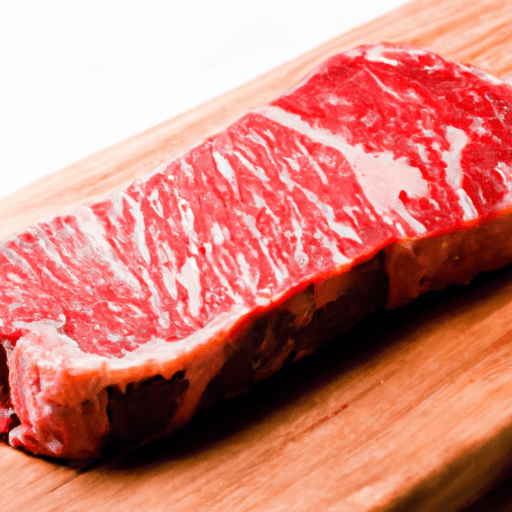The Ultimate Guide to Lean Boneless Strip Steak
If you’re a meat enthusiast looking for a flavorful and lean cut, then lean boneless strip steak should definitely be on your radar. Bursting with rich taste and tenderness, this delicious cut of beef has gained popularity among food lovers and professional chefs alike. In this article, we will take a closer look at everything you need to know about lean boneless strip steak - from its taste and uses in cooking to its nutritional value and fascinating history.
Taste and Texture
Lean boneless strip steak, also known as New York strip steak or Kansas City strip steak, is widely regarded as one of the most flavorful cuts of beef. The rich marbling of fat within the meat gives it a tender and juicy texture, while the fine grain enhances its tenderness. The strip steak boasts a robust, beefy flavor that is enhanced when cooked to perfection.
Common Uses in Cooking
Due to its outstanding taste and texture, lean boneless strip steak is a versatile cut that can be prepared in various ways. Its moderate level of marbling makes it ideal for grilling, broiling, pan-searing, or even stir-frying. The steak can be seasoned with a simple rub or marinade to let the natural flavors shine, or paired with complementary ingredients to create mouthwatering dishes. It is commonly sliced into thick, juicy steaks and served as the centerpiece of a meal. However, it can also be thinly sliced for use in sandwiches, salads, stir-fries, and more.
Nutritional Value
Beyond its delightful flavor, lean boneless strip steak also offers a range of nutritional benefits. This lean cut is a great source of high-quality protein, essential for building and repairing tissues in our bodies. It is also rich in essential vitamins and minerals, including iron, vitamin B12, zinc, and selenium. While it does contain a moderate amount of fat, the strip steak is relatively lower in fat content compared to other cuts, making it an excellent choice for those watching their fat intake or looking for a leaner option.
History and Facts
The origins of lean boneless strip steak can be traced back to the mid-19th century, when it first gained popularity in the vibrant meat markets of New York City. As the name suggests, the strip steak was initially associated with the city’s iconic steakhouse culture. Over time, its exceptional flavor and tenderness spread its fame beyond the city, eventually becoming a beloved choice for steak lovers across the United States and around the world.
Tips for Cooking Lean Boneless Strip Steak
To make the most of this succulent cut of meat, consider the following tips:
- Start by bringing the steak to room temperature before cooking to ensure even cooking throughout.
- Season the steak generously with sea salt and freshly ground black pepper, or experiment with your favorite rubs and marinades.
- Preheat your grill or skillet to a medium-high heat to achieve a perfect sear on the outside while preserving the juiciness inside.
- Cook the steak for a few minutes on each side, depending on the desired level of doneness. Aim for an internal temperature of around 130°F (medium-rare) to 145°F (medium), as the steak will continue to cook slightly as it rests.
Final Thoughts
Lean boneless strip steak is a true gem in the world of beef. With its delectable taste, versatility in cooking, and impressive nutritional value, it’s no wonder this cut has earned a top spot on many meat lovers’ plates. So, whether you’re planning a special meal or simply looking to enjoy a tasty steak, give lean boneless strip steak a try - you won’t be disappointed!
Now that you’re armed with all the knowledge and tips, it’s time to fire up the grill or heat your skillet and embark on a flavorful culinary adventure with lean boneless strip steak. Happy cooking!
Origin: Lean boneless strip steak, also known as New York strip steak, is a popular cut of beef that comes from the short loin of a cow. Its origins can be traced back to the United States.
Common Uses: Lean boneless strip steak is highly versatile and can be prepared in various ways. It is often grilled, broiled, or pan-seared to achieve a flavorful crust while maintaining tenderness and juiciness. It can also be used in stir-fries, sandwiches, or sliced and added to salads.
Nutritional Benefits: Lean boneless strip steak is a good source of protein, essential amino acids, vitamins, and minerals. It is particularly rich in iron, zinc, vitamin B12, and selenium. However, as the name suggests, the cut is leaner than other types of steak, which means it contains less fat. This can be advantageous for those seeking a lower-fat option while still enjoying the flavor of steak.
Unique Properties and Historical Significance: Lean boneless strip steak is known for its fine texture, tenderness, and significant marbling, which contributes to its rich flavor. The cut is often favored for its balance between tenderness and a firmer bite compared to more tender cuts like filet mignon. In terms of historical significance, strip steaks gained popularity in the early 19th century when they became a staple of New York City’s fine dining scene, hence the name “New York strip steak.” Today, it remains a beloved choice among steak enthusiasts and can be found on menus around the world.




Use the share button below if you liked it.
It makes me smile, when I see it.